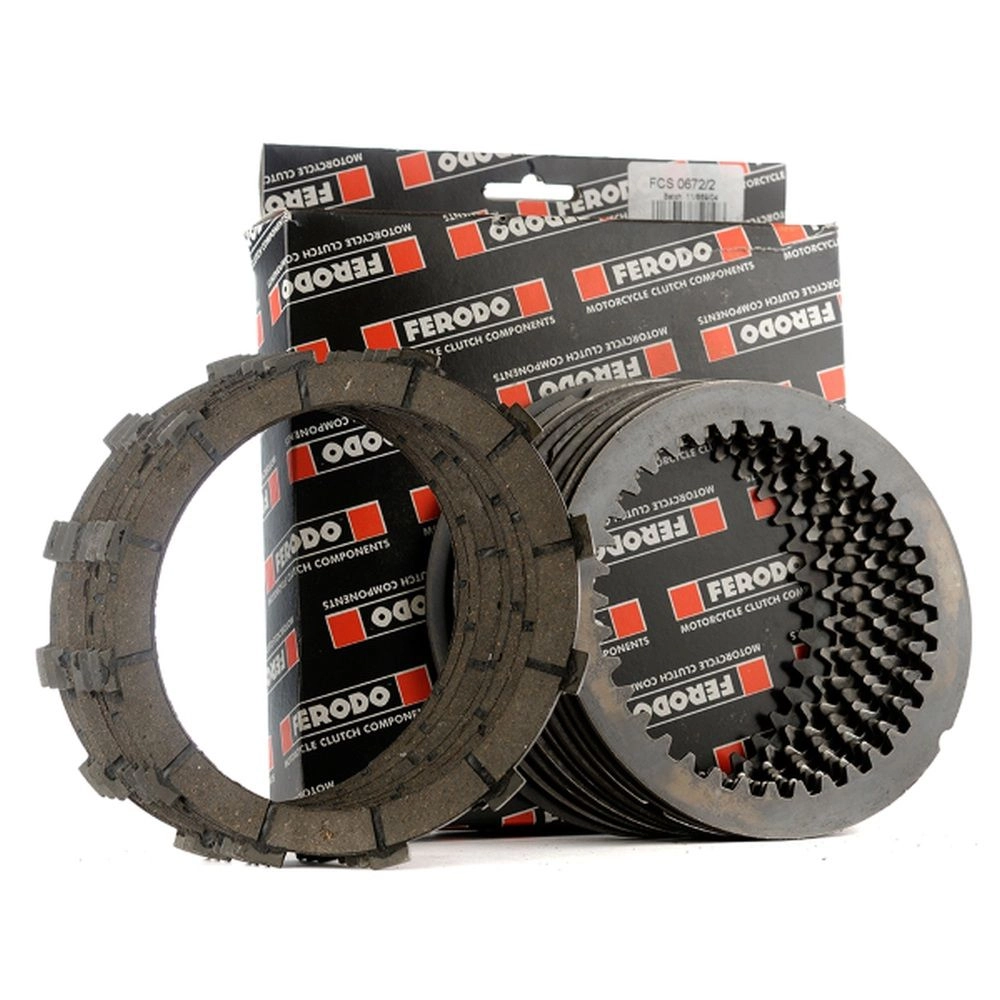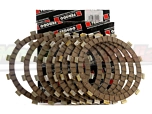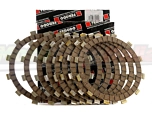Imagine being on your favorite motorcycle, ready to enjoy Italy's finest destinations. But there's a key component that needs careful attention before you set off, playing a crucial role in this experience: the clutch. Without it, the pleasure of riding would be but a distant dream. The clutch is the quiet yet powerful mechanism that lies behind every smooth gear change and decisive start. It's the link between the power of the engine and the freedom of the road.
But what exactly is the clutch? Simply put, it's a system of discs that, when compressed, transmit the engine's power to the transmission and then to your motorcycle's wheels. Think of it as a translator: it converts the engine's energy into movement, allowing you, the riders, to control speed and acceleration with surgical precision.
However, like every unsung hero, the clutch can have its challenging moments. Problems such as slippage, stiffness, and wear of the discs can emerge from time to time. Clutch slippage can give a feeling of lost power, a stiff clutch can make gear shifting somewhat laborious, and wear can lead to less precise and responsive gear changes.
But why do these problems occur? Well, for starters, every time you use the clutch, its discs rub against each other, inevitably leading to wear. Besides this, inadequate maintenance can accelerate this process. An unlubricated clutch cable, for instance, can make the clutch harder to pull. Similarly, improper use of the clutch, like keeping it halfway during riding, can cause excessive heat and premature wear.
In this article titled: “How to Fix the Clutch on Your Motorcycle”, we will tell you all there is to know about your motorcycle's clutch. From its importance to your motorcycle's performance, to understanding and resolving common issues, we will provide you with the knowledge and advice necessary to keep your clutch in stable and optimal conditions.
So, buckle up your helmet, it's time to discover how this essential component can make every journey more enjoyable and safe.
Insights on the Functions of the Motorcycle Clutch
Let's talk about how a motorcycle clutch works. Imagine the clutch as an artist capable of uniting two worlds: that of the engine and that of the wheel. When you turn the throttle, it's the clutch that translates that power request into smooth motion. Inside the clutch housing, a series of alternating discs - some connected to the engine shaft, others to the gearbox - work in sync. When the clutch lever is released, these discs compress against each other, transmitting the engine's power to the transmission. When you pull the lever and the discs separate, interrupting the power flow, you have the opportunity to change gears or stop without turning off the engine.
But not all clutches are created the same. There are two main types of clutch: cable clutches and hydraulic clutches. The fundamental difference? The way they transmit your command from the lever to the clutch itself.
Cable clutches are the classic model. In these, a physical cable connects the clutch lever to the clutch mechanism. When you pull the lever, the cable moves, activating the clutch. This type of clutch is loved for its simplicity and direct feedback. It gives you precise control and a tactile feeling of what's happening inside the mechanism. However, it requires more frequent adjustments and can become harder over time, especially if the cable is not properly lubricated.
On the other hand, we have hydraulic clutches. These use hydraulic fluid to transmit the lever's movement to the clutch. When you pull the lever, the fluid is pushed through a tube to the clutch mechanism, activating it. This type of clutch offers a lighter action. It also requires less maintenance compared to cable models. You don't need to worry about lubricating cables or adjusting tension, but it is crucial to keep an eye on the fluid level and quality.
In essence, the choice between a cable clutch and a hydraulic one depends on your riding style and personal preferences. Some motorcyclists love the direct control feel and ease of maintenance of cable clutches. Others prefer the ease of use and lesser physical effort of hydraulic clutches.
Understanding how your motorcycle's clutch works and its peculiarities will not only help you keep it healthy but will also give you greater control and confidence on the road. After all, when riding a motorcycle, knowledge is power - and power, as we know, is at the heart of every two-wheeled adventure.
Signs that Suggest a Deteriorating Motorcycle Clutch
In every journey or ride we take with our motorcycle, the clutch plays a crucial role. But like every warrior tasked with a critical mission, the clutch too can show signs of wear and fatigue. It is essential to recognize these signals before they become severe problems. So, let's talk about the hidden secrets of a clutch that has seen better days.
We start with frayed cables or damaged sheaths. The clutch cable is the unsung hero that does the dirty and heavy work every time we pull the lever. Over time and repeated use, it can fray or get damaged, like a rope exposed to the elements. A frayed cable not only makes the clutch lever harder to pull but can also compromise your safety. Imagine being in the middle of overtaking and the clutch lever gives way - not a situation you would want to find yourself in. Regular inspection of the cable and its sheath can save the day. If you notice signs of wear, it's time to replace the cable.
The second signal is a stiff clutch or a difficult-to-manage lever. When the clutch is harder than usual, or the lever requires more effort to be pulled, it might be an indication that something is not right. This can be due to various factors: from a cable needing lubrication, to worn clutch springs or an accumulation of dirt and debris in the clutch components. A stiff clutch not only makes riding less enjoyable but can also affect the precision of gear shifting.
In situations like these, installing a reinforced clutch kit can be a proactive solution. These kits are designed to better withstand stress and wear compared to standard clutches. If you are riders who love to push your motorcycle to the limit, or simply desire a more robust and durable solution, a reinforced kit might be the way to go.
Being attentive to these signals will not only help you keep the clutch in good condition but will also allow you to enjoy smoother and more responsive riding. Clutch maintenance is not just a matter of performance, but also of safety. A well-maintained clutch responds better, gives you more control, and helps you stay safe on the road. So, the next time you feel something unusual in the clutch lever, take a moment to analyze the issue.
Motorcycle Clutch Maintenance
At this point, let's discuss a crucial topic for every motorcyclist: clutch maintenance. As we have already mentioned, a well-maintained clutch not only ensures smooth and precise riding but also extends the life of your motorcycle. So, how can we ensure that our clutch is always in optimal condition?
We start with the cleaning and inspection of the clutch levers. Over time, they can accumulate dirt, grease, and debris, which can not only make their action less smooth but also cause excessive wear. Regular visual inspection and cleaning of the levers are fundamental. Check for signs of wear, such as scratches or cracks, and make sure they move freely without any hindrance. A bit of quality grease on the joints and contact points can work wonders in keeping the lever soft and responsive.
Now, let's talk about the lubrication of the clutch cable. This is a crucial step that is often overlooked. A well-lubricated clutch cable allows for a smooth and uninterrupted transmission of movement from the lever to the clutch itself. Over time, the old lubricant can dry out or accumulate dirt, making the cable stiff and the clutch lever harder to use. A good practice is to lubricate the cable at least once a year or whenever you perform a service. It’s a relatively simple job that can be done at home. Disconnect the cable from the lever and the clutch, then use a specific cable lubricant, spraying it along the entire length of the cable. Ensure that the lubricant completely reaches the inside of the cable for optimal lubrication.
Don't forget to also check the path of the cable. A cable that is bent too severely or has an obstructed path can cause excessive friction, making the movement of the clutch stiffer and less responsive. During lubrication, it's an excellent time to check and correct the path of the cable.
Clutch maintenance might seem like a minor task compared to other aspects of motorcycle maintenance, but its impact on the quality of riding is immense.
Motorcycle Clutch Adjustment
When we talk about clutch adjustment, we enter the heart of the riding experience. A well-adjusted clutch means precise gear changes, immediate responses, and above all, smooth riding.
Let's see how to get that perfect feeling from our clutch.
We start with the setting of the ideal bite point. This is the moment when the clutch begins to engage as you release the lever. Finding the right point is a matter of fine balance and personal preference. Some riders prefer a high bite point, close to the rest position of the lever, for quick gear changes and minimal hand movement. Others opt for a lower bite point, for a greater sense of control. The trick is to find that point that suits your riding style. Adjust the bite point by rotating the adjustment screw near the clutch lever or near the clutch itself, depending on your motorcycle's model. It's a game of precision: small adjustments can make a big difference.
Next, we have the adjustment of the clutch cable tension. The tension of the cable affects the feel of the lever and how easily the clutch disengages. A cable that is too tight can make the clutch too "harsh", while a cable that is too loose can make you feel as if you're struggling to completely disengage the clutch. The ideal tension allows the lever to move freely, without excessive play, but without being too tight. Adjust the tension by loosening or tightening the adjustment screw on the cable.
Finally, let's talk about the adjustment of the clutch lever according to ergonomics. It's not just a matter of comfort, but also of control and safety. A clutch lever that perfectly fits your hand reduces fatigue and increases precision in gear shifting. Many modern handlebars allow you to adjust the distance of the lever from the handlebar, tailoring it to the size of your hand and your riding style. If the lever is too far away, you might have difficulty pulling it completely; if it's too close, you might not have enough room for a comfortable grip. Finding the right position will significantly improve your riding experience.
Remember, adjusting the clutch is not a once-in-a-lifetime operation. It’s a continuous process, as the clutch wears and your riding style evolves. Dedicate some time to this important maintenance, and your motorcycle will repay you with every precise and satisfying gear change.
When to Replace the Motorcycle Clutch
There comes a time in the life of every motorcycle when the clutch starts to show its age.
Let's start exploring the signs that suggest the need for a replacement.
The first signal is clutch slippage. When you accelerate, but the motorcycle does not respond with its usual promptness, or the engine revs up but the speed does not increase accordingly, the clutch could be to blame. This happens when the clutch discs are worn out and can no longer adequately transmit power. Another sign is a clutch that does not disengage completely. If changing gears becomes difficult or if you feel the motorcycle dragging even with the clutch fully pulled, it is a clear signal that the discs are clinging too tightly to each other.
Now let's talk about the procedure for dismantling and replacing the clutch. This might seem like a daunting task, but with a bit of knowledge and the right tools, it’s an operation that many enthusiasts can perform without problems.
First, you will need to remove the clutch cover. This usually means removing several bolts in a specific order - a good service manual for your motorcycle will give you precise instructions. Once the cover is removed, you will find the clutch pack: a set of alternating metal and friction material discs.
The next operation is to remove these discs. Keep in mind that you will need to replace both the metal discs and those made of friction material, even if only one of the two types seems worn. When replacing the discs, it is essential to follow the manufacturer's specifications for the type of discs and their installation order. A mistake here can lead to operating problems or even damage the engine.
Once the new discs are inserted, reassemble the clutch pack and the cover, ensuring you follow the tightening specifications for the bolts. After the replacement, it is a good practice to perform a short test in a safe area to ensure that the clutch functions correctly.
Conclusion
In this article, we have explored several crucial aspects that every two-wheel enthusiast should know.
Firstly, we discovered the importance of regular clutch maintenance, which not only ensures optimal performance but also extends the lifespan of your motorcycle.
We also learned to recognize the signs of a deteriorating clutch, such as slippage, stiffness, or difficulty in changing gears. These signals are the first indications that it might be time to consider a replacement.
Clutch adjustment is another key element. Having the right cable tension and an ideal bite point not only improves comfort during riding but also increases your safety and control over the motorcycle.
And last but certainly not least, we looked at when it's time to replace the clutch and how an appropriate dismantling and replacement procedure is crucial to ensure that the motorcycle continues to function as it should.
Now that you have all this information, you might wonder where to find the best components for your motorcycle. This is where we at MotoShopItalia come into play. On our site, we offer a wide selection of high-quality components, from clutch cables to complete clutch kits, to ensure that every motorcyclist can purchase the best products available on the market. Whether you need spare parts for regular maintenance or specific components for a more complex repair, our catalog has what you are looking for.
MotoShopItalia's offering also includes high-quality components from renowned brands EBC and Ferodo. These names are synonymous with reliability and performance in the world of two wheels. Whether it's tackling winding roads or enjoying a smooth ride in the city, EBC and Ferodo products guarantee an unparalleled riding experience.
EBC's clutch kits are designed to offer superior durability and resistance, ideal for those looking for a quality upgrade or a reliable replacement. Whether you ride a sporty motorcycle or a classic cruiser, EBC has the perfect solution for your specific needs.
Ferodo, on the other hand, is a brand that has built its reputation on products that provide consistent and reliable performance. Their clutch components are designed to maximize the feeling of control and response, thus improving safety and riding pleasure.
To conclude the article, remember that taking care of your motorcycle means nurturing that special connection every motorcyclist has with their two-wheeler. And we at MotoShopItalia are here to support you at every stage of this journey.

 Italiano
Italiano





